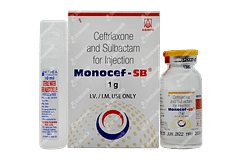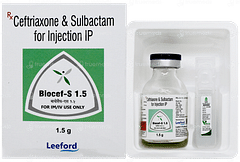Ceftriaxone + Sulbactam
Uses of Ceftriaxone + Sulbactam
Ceftriaxone + Sulbactam is primarily used to manage bacterial infections and is a part of the antibiotic group of medicines.
It is also useful in managing pneumonia, skin and skin structure infections, intra-abdominal infections, urinary tract infections, gynaecological infections, septicaemia, bone and joint infections, meningitis and surgical prophylaxis.
Side effects of Ceftriaxone + Sulbactam
Diarrhoea
Nausea
Vomiting
Rash
Injection site reactions
How Ceftriaxone + Sulbactam works
- Ceftriaxone is a cephalosporin antibiotic. It stops bacteria from growing by weakening their cell walls until they break apart and die. It does this by attaching to and disabling enzymes responsible for making peptidoglycan, a key building block of bacterial cell walls.
- Sulbactam is a beta-lactamase inhibitor. Some bacteria produce special enzymes, called beta-lactamases, that can destroy cephalosporins like ceftriaxone. Sulbactam stops these enzymes from working, protecting ceftriaxone and allowing it to do its job against the bacteria.
- Together, Ceftriaxone and Sulbactam create an effective defense against many types of bacteria, including some that could otherwise resist ceftriaxone.
Certified content
Written By

MSc (Applied Genetics)
Reviewed By

BMS, FMC, MD Resident
Expert Advice
Dosage Forms Available
Ceftriaxone + Sulbactam is available as a sterile powder for reconstitution, administered as an intramuscular injection or intravenous infusion.
Age and Dose Restrictions
This medicine is suitable for both adults and children.
Contraindications
Ceftriaxone + Sulbactam is contraindicated in patients with known hypersensitivity to ceftriaxone, sulbactam, other cephalosporins, or any component of the formulation.
Other Medications to Avoid
This combination may interact with aminoglycosides (e.g., gentamicin, amikacin), oral anticoagulants (e..g, warfarin), and uricosurics (e.g., probenecid).
Overdose and Missed Dose
An overdose of this medication may cause severe reactions like convulsions or seizures. If you observe these symptoms, inform your doctor immediately.
If you forget to administer this medicine, do so as soon as you remember. However, if it is close to the next scheduled dose, skip the missed dose.
Management of Side Effects
Most side effects are temporary and generally harmless and resolve when discontinuing this medicine. However, if you experience any severe side effects or worsening of any of the symptoms, please consult your doctor.
Drink plenty of fluids to help manage diarrhoea.
Resting or sleep can help manage nausea or vomiting.
Lying down in a dark room may help manage headaches.
Use in Driving and Operating Machinery
This medication may cause dizziness or confusion. Avoid driving or operating heavy machinery if you experience these side effects.
Use in Pregnancy and Lactation
The safety of Ceftriaxone + Sulbactam in pregnancy and nursing mothers is not established. Consult your doctor before using this medicine if you are pregnant or breastfeeding.
Caution in Other Conditions
Patients with renal impairment should exercise caution when taking this medicine. Dose adjustment is required. Patients with a history of gastrointestinal disease, especially colitis should also be cautious when using this combination.
Special Dietary and Lifestyle Recommendations
Maintain good personal hygiene to avoid spreading the infection to others.
Follow doctor's instructions regarding rest and activity levels.
Frequently asked questions
Can Ceftriaxone + Sulbactam be used for common cold or flu?
No, Ceftriaxone + Sulbactam is an antibiotic, and antibiotics do not work against viruses that cause common colds or flu.
Can one take Ceftriaxone + Sulbactam without a prescription?
This medicine should not be taken without a doctor's prescription. It is important to use this medicine responsibly to prevent antibiotic resistance.
Can Ceftriaxone + Sulbactam be used in newborns?
Ceftriaxone + Sulbactam should be used with caution in newborns, especially those with high levels of bilirubin in the blood, due to the risk of bilirubin encephalopathy. This should be used only under the guidance of your baby's doctor.
Will Ceftriaxone + Sulbactam have any effect on mood?
There is no documented evidence that Ceftriaxone + Sulbactam directly affects mood. However, people who are unwell may experience changes in mood due to illness or discomfort.
Can I take Ceftriaxone + Sulbactam if I am allergic to penicillin?
As Ceftriaxone + Sulbactam belongs to the cephalosporin class of antibiotics which are related to penicillin, some individuals who are allergic to penicillin may also be allergic to cephalosporins. It is important to inform your doctor about any known allergies before starting this medication.
Can natural remedies replace Ceftriaxone + Sulbactam in managing bacterial infections?
No, natural remedies cannot replace antibiotics like Ceftriaxone + Sulbactam in managing bacterial infections. Antibiotics are specifically designed to inhibit bacterial growth and they are required for treating bacterial infections.
How quickly does Ceftriaxone + Sulbactam start working?
The timing can vary based on the type of infection and its severity but generally, you may start to feel better after a few days of treatment. However, you should complete the full course prescribed by your doctor even if you feel better earlier.
Ceftriaxone + Sulbactam in other salts
List of Medicines for Ceftriaxone + Sulbactam








Subscribe
Registered Office Address
Grievance Officer
Download Truemeds

Contact Us
Our customer representative team is available 7 days a week from 9 am - 9 pm.
v3.7.5
Our Payment Partners








